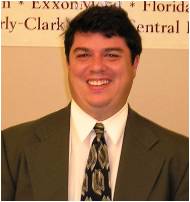- By Research Area
- By University
Directory
Faculty
Directory Details
[Return to Previous Listing]
Jim Brenner
Assistant Professor, Chemical Engineering, Florida Institute of Technology
Phone: (321) 674-8086
Florida Institute of Technology
150 West University Boulevard
Melbourne, FL 32901-6975
https://services.fit.edu/profiles/profile.php?value=38
Education:
B.S., University of Delaware; M.S., The University of Michigan, 1991; Ph.D., The University of Michigan, 1994
Research Interests:
Research Interests
Dr. Brenner's research activities focus on development of nanostructured adsorbents, purifiers, and heat transfer media for the hydrogen, microelectronics, specialty chemicals, and pharmaceutical industries. The key themes of his work are 1) development and characterization of novel porous materials; 2) applications involving interstitial compounds such as hydrides, nitrides, and carbides; and 3) characterization and applications development involving interactions of molecules with surfaces.
Current Research
Since joining the faculty at Florida Tech in 1998, Prof. Brenner has worked in the areas of hydrogen storage, purification, and sensing. All of these areas continue to build on the same fundamental concepts described previously. Most of his work has focused on development of metal hydride-based (typically Pd alloy) thin films on porous stainless steel (PSS) foam supports for hydrogen purification. Hydrogen purification is critical to the implementation of hydrogen fuel cells, as the fuel cells are intolerant of even parts per million of impurities of sulfur and CO. No one would want their hydrogen fuel cell vehicle to die prematurely of "engine failure" after only a few thousand miles. This work is part of a larger, Florida Tech-wide effort toward a completely hydrogen-driven airplane. The fluxes through such thin film hydrogen permeation membranes are limited by the thickness of the metal hydride thin film, which is in turn limited by the maximum pore size of the support. As a result, in 2006, he has begun work toward partially filling the PSS supports with a templated porous carbon, before depositing a now much thinner, bimetallic metal hydride thin film on top using concepts developed by Raymond Schaak of Texas A&M. Also in 2006, Dr. Brenner is beginning development of nanoporous metallic foams based on the pioneering work of Bryce Tappan of Los Alamos National Laboratory. In 2001, Dr. Brenner collaborated with Dr. Martha Williams of NASA-KSC and Prof. Gordon Nelson of Florida Tech on a family of porous polymer candidates to replace the now infamous orange insulation around the liquid oxygen tanks of the Space Shuttle Columbia that flaked off during the 2003 disaster. In 2001, Dr. Brenner began development of porous polymers for molecular recognition, with applications in the electronic nose and tongue businesses and in detection and purification of enantiomers used in the pharmaceutical, agricultural chemical, and fragrance industries. Recently, he has begun development of an electronic nose as well, based on collection of impedance spectra of the responses of an array of polymer/carbon composites deposited on capacitors to a range of scents. The detection of such aromas, as well as quantification of concentrations, is determined via advanced pattern recognition algorithms such as linear discriminant analysis. Both the sensing and the pattern recognition are accomplished using National Instruments LabView and a LabView pattern recognition toolkit from Camo Corporation. Dr. Brenner also has plans for adapting this technology for the detection of molecules and macromolecules in liquids, with an eventual goal of detection of cancer biomarkers in blood and urine for use in an inexpensive kit associated with a yearly physical examination. In 2005, Dr. Brenner began work on development of an array of porous carbons around a family of monodispersed silica templates using molecular self assembly methods using sucrose, phenol and formaldehyde, or resorcinol and formaldehyde as the carbon- forming precursors. Upon extraction of the silica using KOH, the pores in the carbons were the imprints of the silica templating agents. In late 2006, Dr. Brenner plans to evaluate these template porous carbons as novel gas diffusion layers for hydrogen fuel cells. Gas diffusion layers have largely been ignored in fuel cell development and are currently best described as a 2-D mesh of carbon fibers similar to those found in paper. If fuel cells are going to have sufficiently high current densities in order to be practical in vehicles, one problem that must be solved is the relatively poor mass transfer through existing gas diffusion layers. The goal of the templated porous carbon project is to discover an optimal pore size distribution for such gas diffusion layers.














